Heading out the door? Read this article on the new Outside+ app available now on iOS devices for members! Download the app.
This story was originally published in April 2022. We’re re-releasing it now because the author, Mario Heller, recently released an excellent short film about his experience climbing up and flying off Cerro Torre. Check out his film out at the bottom of the article.
*
For years, when I looked at photos of Cerro Torre’s snowy crown and steep vertical walls, I didn’t just see one of the most iconic alpine objectives on earth: I saw the perfect mountain to fly off. Fabi Buhl had done the first climb and fly in 2020, but his climbing partners had to take the long slow descent. I dreamed of climbing the peak with a strong team, taking off together, and landing side by side. But I also knew it was easier to imagine a goal like this than to make it into a reality: all the wheels would have to spin the right way for this to work.
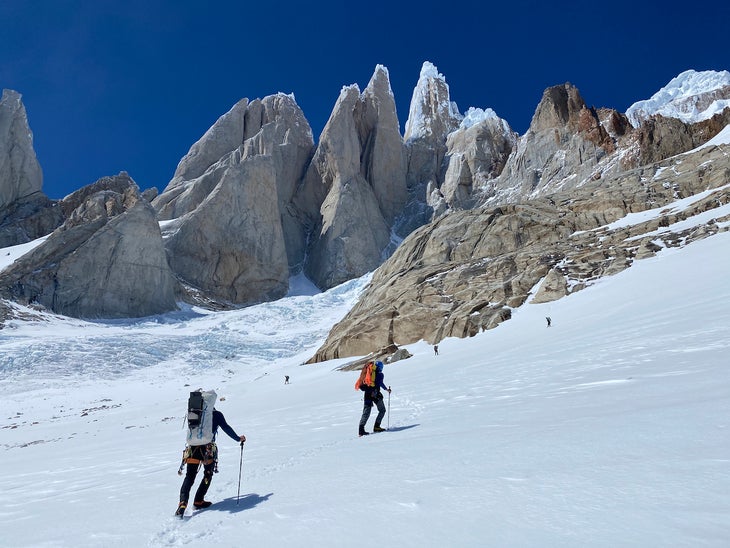
Waiting in Chalten while our good weather window drew closer, Roger, Pablo, and I watched the video of Fabi’s launch over and over. The takeoff area didn’t look so small in the video, but we supposed it would seem different when we were standing thousands of feet above the glacier with a tail wind complicating the takeoff.
We gave Fabi a call and asked him about the conditions he had for his flight. He told us that the weather window in front of us looked very similar to his, and gave us some more advice. That’s when we started getting both super excited and super nervous. Were we actually going to try it?
We packed for a 4-day trip and started walking from El Pilar towards Marconi Pass. We went through the forest, along the Rio Electrico, alongside a few lakes, and up onto the glacier on the border of Chile. After a couple of hours, we came across an Argentinian team that, like us, intended to climb Cerro Torre’s Ragni Route (600m, 90˚, M4). Pablo knew everyone—Luciano Cortez, Sebastián Beltrame, and Ramiro Greco—and we all camped together that night on the glacier.
The second day started out much like the previous one ended. Everything was snow and ice as we walked over Patagonia’s inland ice sheet. For a second time, we saw another team on the horizon—this time it was Agustín Mailing and Pedro Fina, also Argentinian and also on the way to climb Cerro Torre by the Ragni Route. From then on, our three teams—composed of six Argentinians and two Swiss—climbed almost as one for the rest of the ascent.

We carried on into the Circo de los Altares on the west side of Cerro Torre, which is one the most breathtaking places I have ever seen: spectacular mountains with big hanging glaciers between them. Approaching Cerro Torre’s west face via some rocky steps, we reached the first snowfields. By now we were far away from everything. When we climbed the first mixed pitches, we quickly realized how heavy our bags were with the added weight of the paragliders. At the next ice field, we decided to call it a day, bivvying just below the Col de la Esperanza.
Our alarms went off at midnight—the very beginning of day three. We could vaguely see the first steep ice pitches above us in the darkness. Pablo led our group to the Elmo (a Helmet-shaped ice feature), where he passed the lead to me. It was my first encounter with the mushroom ice for which the Ragni Route is famous. These unique and bulbous ice formations are formed by the strong winds blasting into Cerro Torre and sticking the ice and snow to the granite walls like plaster. It was completely different to anything I had ever seen. I started climbing the steep snow and ice. At first I found some good ice that would take a screw, but then the composition of the ice worsened. Even my axes no longer found solid purchase, which forced me to scrape at the rime ice to find better ice beneath. In this way I eventually climbed over the bulge to the top of the mushroom.
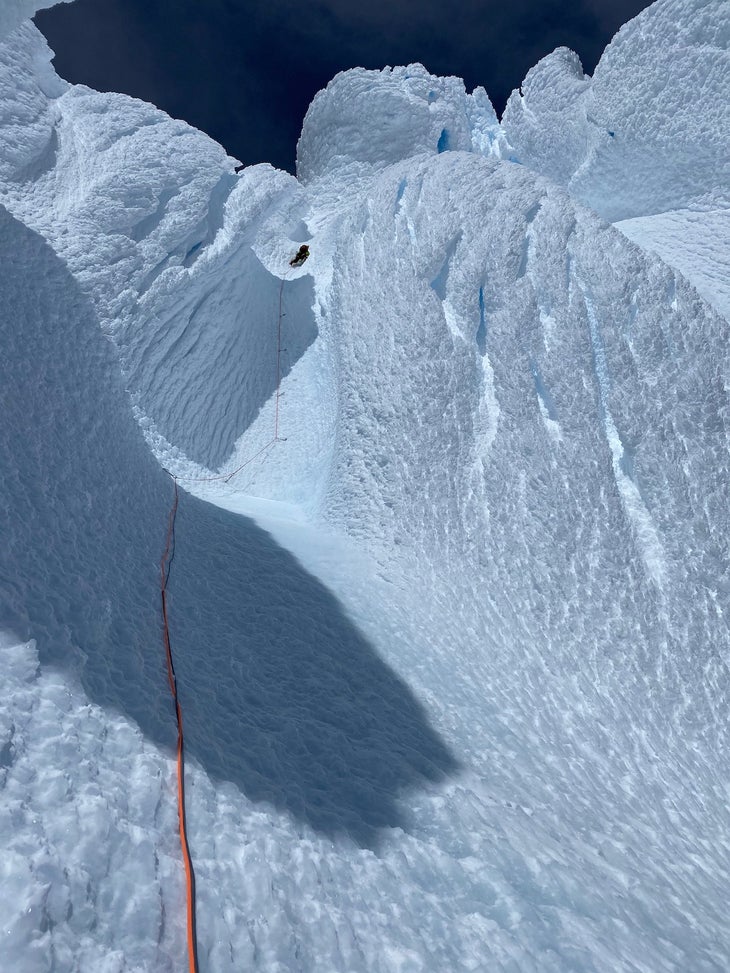
Roger took the lead on the headwall above, which included the first two pitches of properly steep (90°) ice. Our packs felt very heavy by now since we’d been climbing for 10 hours straight. Roger brought us up the head wall into the sun. We had only four more pitches to the summit, but it was getting warm, the rime ice getting softer. I took the lead for the next pitches, climbing up an ice groove surrounded by mushrooms. It looked otherworldly. There was snow constantly falling on top of me and I was soaked to my underwear. Just two more pitches now. We came around the corner and saw three wind-formed tunnels in the rime ice. Odd as it may seem, climbing through these tunnels is the safest way to climb those mushrooms. But all of these ones had very bad entrances. I chose the third tunnel and was able to place a cam for protection in the rock. Then I started stemming up, climbing the rime ice leaning against the rock. It felt very awkward and poorly protected.
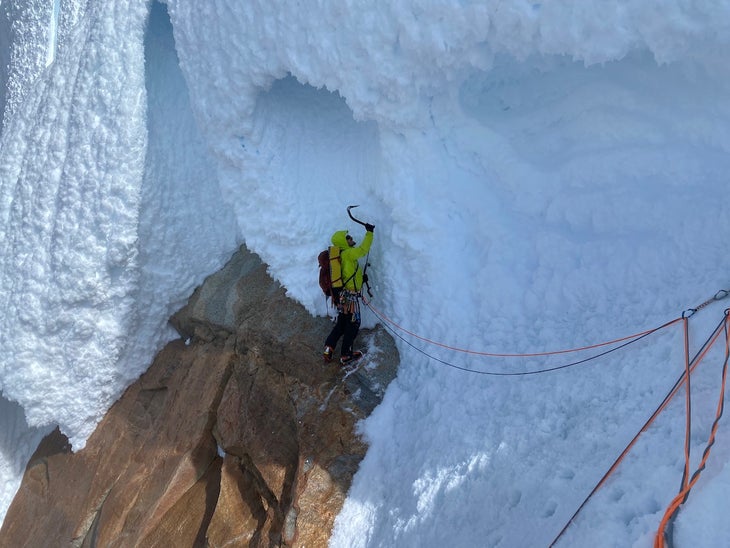
When I got my upper body into the tunnel, I found some acceptable ice for my axes, but my feet were still out on the rock with nothing to stand on. I looked at my last piece of protection well below me and tried not to think about what would happen if I fell. Eventually I managed to get my feet in the tunnel and onto better ice so I could place a screw. That’s when it got a lot easier. I climbed up through the tunnel and reached the top of the mushroom, where I dug a hole and buried a rucksack to make an anchor. Then I belayed the rest of the team up.
It was now 8.00 p.m., and we were all very tired. It was too warm to climb the final pitch to the summit, so we spent the night just under it. The two Argentinian teams came up to meet us and we all enjoyed the sunset together. Above us loomed the final pitch of Cerro Torre: It looks like a crown shaped from snow and ice. There was almost no wind, and I went to bed still soaked from the snowfall, but utterly exhausted from a long day of climbing.
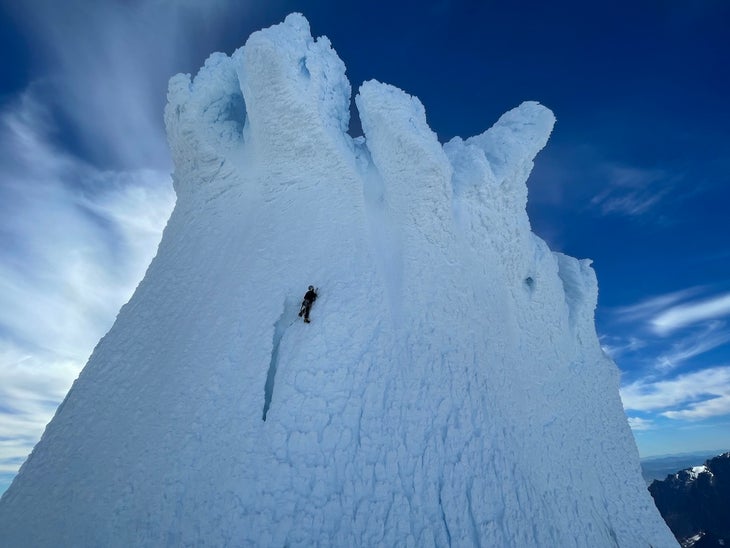
Agustín Mailing and Pedro Fina started first on the final morning, attaching wings to their ice axes to get more surface area and get better purchase in the steep snow. Agustín climbed through a tunnel and then entered a groove. He was moving quickly in this terrain. Roger followed him up, then Pablo and me. At first, on the summit, we were full of emotions, falling into each other’s arms, but soon we started discussing our take-off. There was almost no wind, which was perfect, and the take-off area looked good—though it did, as we suspected, seem a bit smaller than it had seemed in Fabi’s photos and videos. Luckily, there was enough space for all three gliders.
Pablo planned to go first, followed by Roger, then me. I was very glad that there were two more climbing parties behind us, planning to descend on foot, which meant I wasn’t alone on the summit after the other two were in the air.
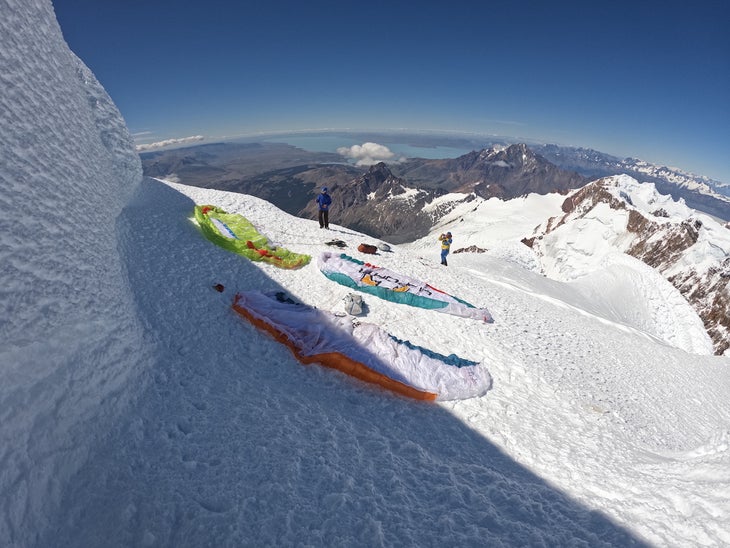
By the time Pablo was ready, a bit of tailwind had sprung up, so he waited for a while for the wind to change. I walked over to hold his glider when it started to fold in on itself. The tailwind stopped and Pablo announced, “OK, I go,” and started running. The wing came up perfectly, and he ran off the edge, yelling “Yeeehaaa.” A few moments later, Roger did the same. Both disappeared quite quickly into the blue sky.
I returned to my glider and readied myself, but the wind was constantly changing. My glider rolled in on itself. I laid it back out. Ramiro Greco, one of the Argentine climbers, came down to hold my glider so I could finish getting ready. I was getting a bit tense. “Don’t be nervous,” I told myself. “Just think of what you have to do now. Clip in, get in the right position, wait for the good moment.”
I waited. When everything was ready and the wind seemed to be cooperating, I said, “Tschüss” (“Bye” in German) and started running. My glider came up nicely. I got good feedback just as I reached the edge and I stepped off.
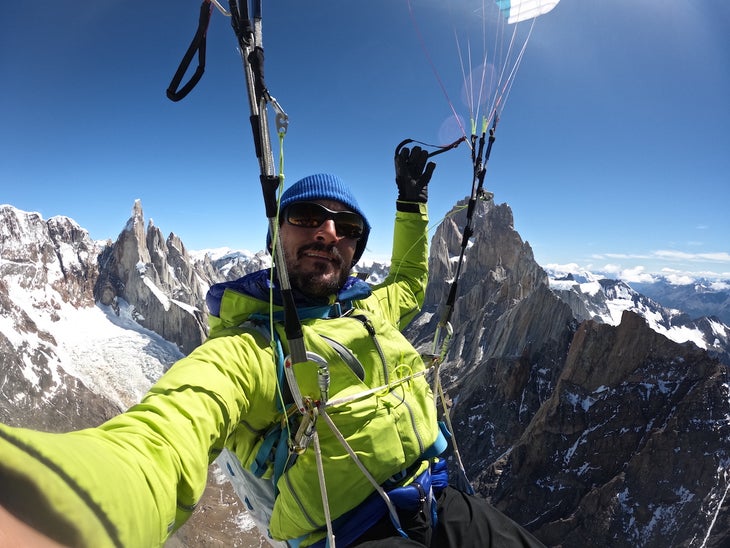
My emotions were going crazy. I couldn’t believe we’d actually just taken off from Cerro Torre. The air was so calm, I couldn’t feel any turbulence, so I took off my helmet where the GoPro was attached and started taking lots of photos and videos. But where were Roger and Pablo? I passed Laguna Torre. To the left of me was Fitz Roy. The landscape was unbelievable: granite towers reaching up into the sky surrounded by glaciers dropping right into lakes with rivers flowing out through the forest and disappearing in the distance. I started to look for viable landing spots, and spotted Pablo and Roger approaching a clearing next to Rio Fitz Roy. I followed and landed beside them and we fell into each other’s arms.
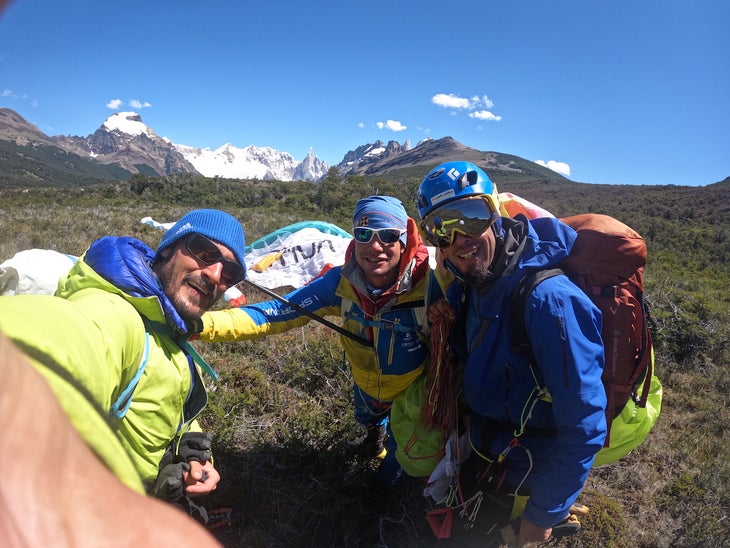
We pack up our gliders and start walking back to Chalten. The trip took only one hour. We had saved ourselves two days of rappelling and walking.
We still can’t quite believe what we just did.
About the author
Mario Heller lives in Interlaken, Switzerland, and is a passionate climber and paragliding pilot. He works as a carpenter, tandem paragliding pilot, and photographer. Of his background he writes: “Growing up near the mountains in Switzerland and starting rock climbing made me fall in love with the mountains. 10 years ago I moved to Interlaken. This opened up a whole new world for me. I started paragliding and mountaineering. Along the way I met new people from around the world. Meeting new people and sharing adventures builds a bond which is very strong. This creates friendships for life.”